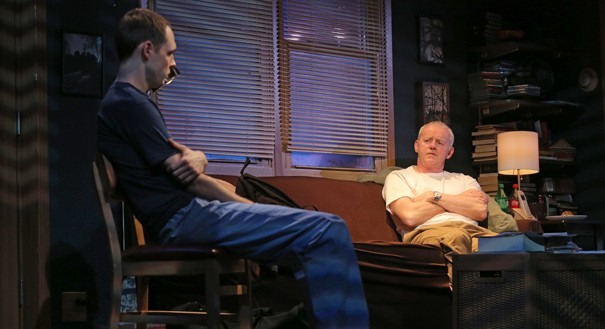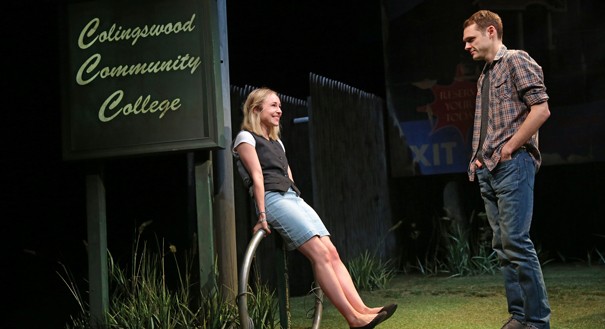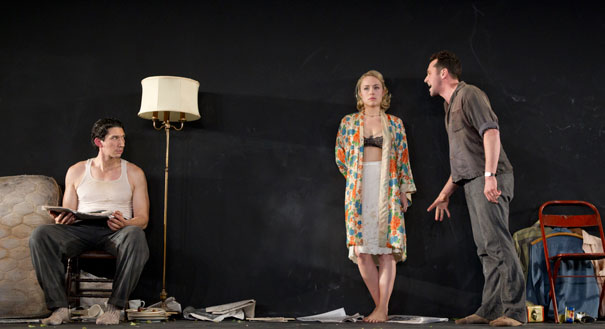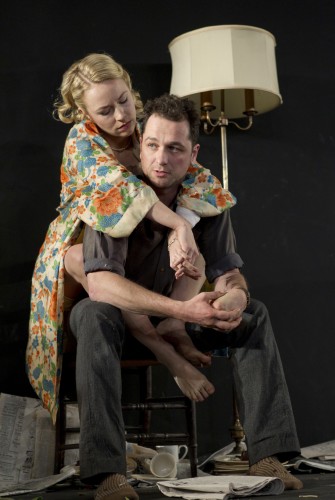
Father (David Morse, r.) and son (Christopher Denham) have a serious chat in THE UNAVOIDABLE DISAPPEARANCE OF TOM DURNIN (photo by Joan Marcus)
Roundabout at Laura Pels Theatre
Harold and Miriam Steinberg Center for Theatre
111 West 46th St. between Sixth & Seventh Aves.
Tuesday – Sunday through August 25, $71-$81
212-719-1300
www.roundabouttheatre.org
After serving five years in prison for Madoff-like financial wrongdoings, disbarred lawyer Tom Durnin (David Morse) thinks he can just walk right back into his family’s life, but his wife, Karen (Lisa Emery), has left him, his daughter wants nothing to do with him, and his son, James (Christopher Denham), is torn when his father suddenly shows up in his ramshackle house, in a dilapidated would-be neighborhood that was also a victim of the mortgage crisis. His father’s fall from grace has shattered James, who had to leave Yale and now is studying fiction writing at a local college, where he meets the emotionally injured Katie (Sarah Goldberg), who has family issues of her own. Tom, who is working as a barista at a Borders bookstore — which itself would go out of business shortly — tries to find out from James where Karen is, but he’s not telling. Meanwhile, Tom meets with his son-in-law, Chris (Rich Sommer), whom he helped set up in the law firm where he was once a partner, trying to convince him to get him any job with the company, but the meek Chris, who has been told by his wife not to talk to Tom, is not about to risk his career by endorsing Tom’s return to the firm where he committed his dirty dealings.

James (Christopher Denham) and Katie (Sarah Goldberg) deal with difficult family issues in play about financial crisis (photo by Joan Marcus)
The Unavoidable Disappearance of Tom Durnin takes place in June 2009 in “the American exurbs, Sam’s Clubs and SUVs and Caribou Coffee and the eerie, shuttered windows of foreclosed strip malls,” representing the America that was devastated by the financial meltdown. Morse is excellent as the determined title character, who believes that he has done his time and can now get back on the path he was on, both personally and professionally, unable to recognize the continuing results of his actions. The play, written by Steven Levenson (The Language of Trees, Core Values) and directed by Scott Ellis (The Mystery of Edwin Drood, Harvey), works best when Morse is onstage, his steely gaze and solid posture revealing a man who firmly believes he has paid his price and can’t understand why everyone has turned their back on him. The scenes in which James and Katie read their writings come off as gimmicky, a too-easy way to show these characters’ twisted emotions. The country is still recovering from the financial crisis brought on by men like Tom, and Levenson’s play does a good job using the Durnin family as a microcosm of the ongoing fall-out — in which very few people have actually gone to prison for what they have wrought. (There will be free talkbacks with members of the cast following the 2:00 performance on July 13 and 21 and August 4, 10, and 17.)

